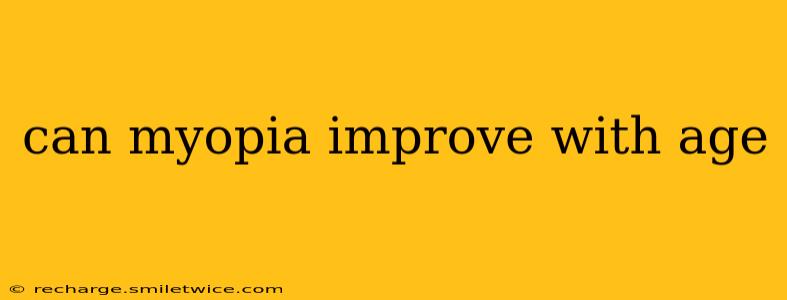Can Myopia Improve With Age? Understanding Myopia Progression and Potential Changes
Myopia, or nearsightedness, is a common refractive error where distant objects appear blurry. While it's often associated with childhood and adolescence, many wonder: can myopia improve with age? The short answer is complex: it's unlikely to significantly improve, but the rate of progression can change, and in some rare cases, minor improvements might occur.
Let's delve deeper into the nuances of myopia progression and the potential for changes as we age.
Does myopia always get worse?
This is a common misconception. Myopia typically progresses most rapidly during childhood and adolescence, slowing down considerably in the early twenties. While it rarely gets significantly better, the rate of worsening generally decreases as you get older. For most people, their myopia stabilizes in their early to mid-twenties. However, this isn't universally true; some individuals may experience a slow progression into their thirties or even later.
Can myopia improve after age 20?
While significant improvement after age 20 is rare, subtle changes are possible. The axial length of the eye (the distance between the cornea and retina) is the primary factor in myopia. While this length typically doesn't shorten, some minor changes in the eye's refractive power can occur due to factors like lens changes related to aging. These changes are usually minimal and unlikely to significantly alter your prescription.
What factors influence myopia progression?
Several factors contribute to myopia progression, and understanding these can be crucial in managing its severity:
- Genetics: A family history of myopia significantly increases your risk.
- Near-work activities: Prolonged periods of near-focus tasks, like reading or using computers, are associated with increased myopia progression, especially in children.
- Time outdoors: Spending time outdoors has been shown to have a protective effect against myopia development and progression. The exact mechanism is still under research, but exposure to natural light may play a role.
- Ethnicity: Certain ethnic groups have a higher prevalence of myopia.
- Eye health: Underlying eye conditions can also affect myopia progression.
What treatments can slow myopia progression?
Several treatments aim to slow myopia progression, particularly in children and adolescents. These include:
- Atropine eye drops: Low-dose atropine eye drops have demonstrated effectiveness in slowing myopia progression.
- Multifocal contact lenses: These lenses provide different focal points across the lens, potentially reducing strain on the eye.
- Orthokeratology: This involves wearing special contact lenses overnight that reshape the cornea to temporarily correct vision during the day.
How can I manage my myopia?
Regardless of age, managing myopia involves regular eye exams to monitor progression and addressing any vision-related issues. Maintaining a healthy lifestyle, including sufficient outdoor time and breaks from near-work activities, can contribute to overall eye health.
Can myopia be cured?
Currently, there is no cure for myopia. Treatments focus on managing the condition, slowing progression, and correcting vision to improve quality of life. While some individuals might experience a slight reduction in myopia with age, it's not a reliable expectation, and it’s crucial to consult an ophthalmologist for personalized guidance.
Disclaimer: This information is for educational purposes only and should not be considered medical advice. Always consult with an ophthalmologist or optometrist for diagnosis and treatment of myopia. They can provide personalized advice based on your individual circumstances and medical history.
